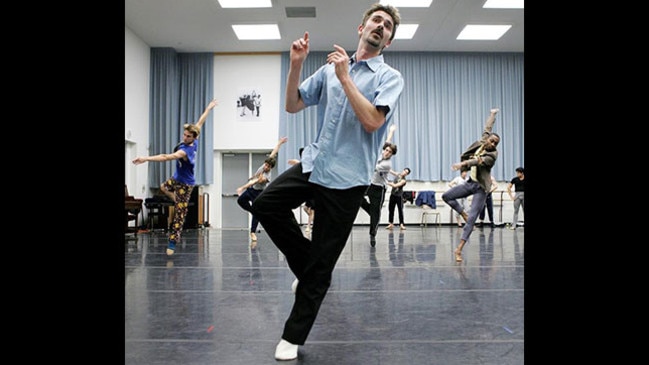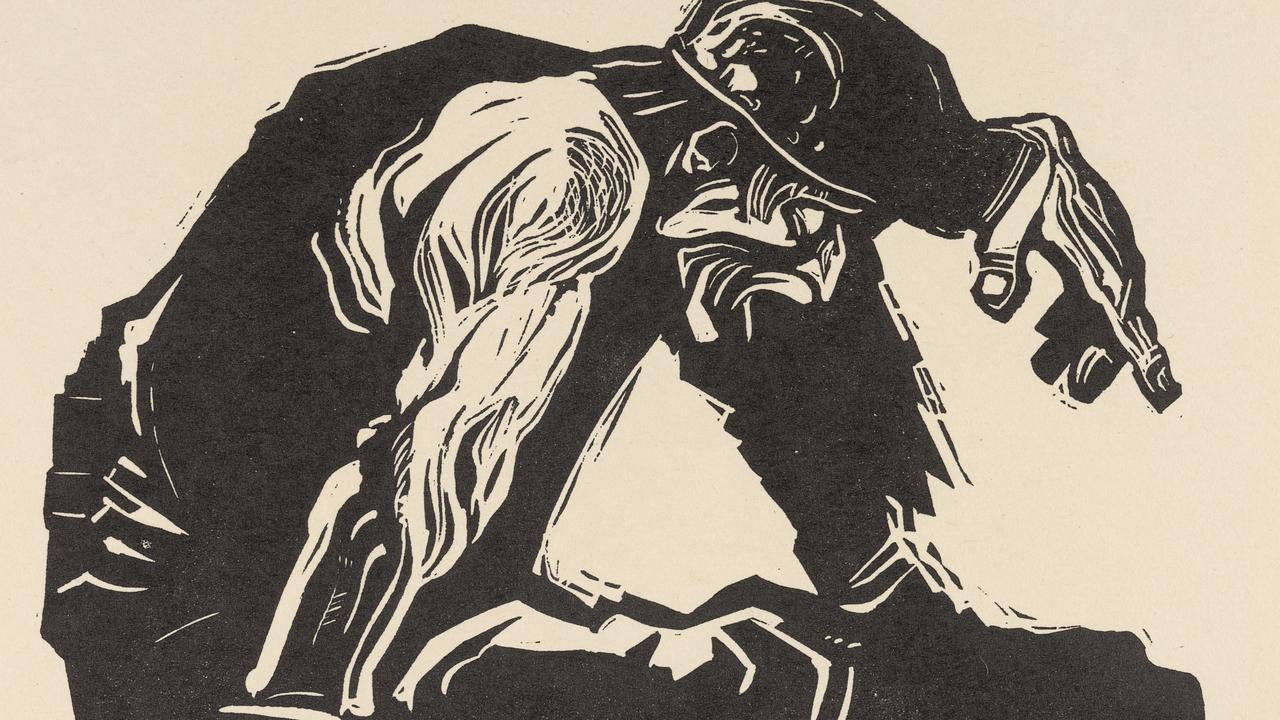Stanton Welch: artistic director brings Houston Ballet to Australia
Stanton Welch is bringing a new Romeo and Julietfrom his adopted home in Houston to his old stomping ground.

At the age of five or six, Stanton Welch watched, entranced, as his mother Marilyn Jones danced in Romeo and Juliet with the Australian Ballet. Then he grew up and danced in the ballet himself. Last year, he completed another link in the chain — launching the world premiere of his own version of the ballet in Houston, Texas, his adopted home.
Now he’s closing the circle when he brings his $US2 million ($2.7m) production to Australia for an exclusive Melbourne-only local premiere this month as part of the Australian Ballet’s season. It will be performed by the 54-strong Houston Ballet, the American dance company he has led as artistic director since 2003, in its first visit to Australia.
Welch, the Melbourne-born resident choreographer of the AB and a former leading soloist with the company (his parents are ballet royal couple Garth Welch and Jones; his brother Damien was a principal dancer), concedes a certain level of nerves as he prepares for this homecoming.
Twenty-five years ago, he began choreographing in Melbourne. He returns now with his newest, and perhaps most personally resonant, work. Over the phone from Texas, he says Australian Ballet artistic director David McAllister had long been keen to present the company — rated among the top handful in the US — in Australia. The clincher was when Welch’s new ballet about the Bard’s star-crossed lovers was announced.
“David said, ‘OK, let’s do it’, although he hadn’t even seen it at that point.” He mock-groans. “I feel it’s a bit hard to bring it home because everyone is so Cranko there” — he is referring to the famous 1962 version of the ballet made by John Cranko for the Stuttgart Ballet. “And of course I have to pay homage to him. Cranko is the guy.”
Tyranny of comparisons aside, Romeo and Juliet is the ideal ballet to showcase his troupe’s strong technique and storytelling abilities, Welch believes. He speaks of the company with paternal pride. Now in his 13th year as artistic director, he has incubated and nurtured a generation of “babies, who are now hitting 30, unbelievably — and there’s a whole generation of babies coming up behind them”.
One of this Welch-reared generation is principal dancer Sara Webb, a lithe, elegant veteran who speaks as passionately about her Mormon faith (“anything that brings balance and perspective makes you a better dancer. That is what my faith does for me — spiritually, emotionally, socially, and physically”) as she does of Welch’s tenure as director.
He has done good, she tells Review: “As far as the dancers are concerned, Stanton constantly pushes us to improve — to move differently, move faster, pick things up quicker, be more mouldable — by exposing us to so many different choreographers and a broader repertoire. I think we are one of the hardest working companies in the world.”
Webb will share the lead role in Melbourne with fellow principals Karina Gonzalez (“Italian-looking, she has the features to me that look like a film version of Juliet,” says Welch) and Melody Mennite (“a Meryl Streep-style actress-dancer who just transforms with every role”).
The Texan-born, whippet-thin dancer — blessed with “an exquisite line, with perfect legs and feet for a ballerina, and she’s also a very emotional, light performer”, according to Welch — has been principal since 2003, shining in all the key roles of the classical and modern canon. Romeo and Juliet, however, has always been a favourite.
“It is always nice to revisit a ballet, especially one with a role that requires you to put so much of yourself emotionally into the character,” says Webb. “I was a very different Juliet in 2005 than I am now. I have more life experiences to draw from to bring to the stage this time around. My husband, who was deployed to Iraq [then] is, thankfully, safely home. We also now have three beautiful children who have definitely made life a busier and more wonderful adventure. Of course, I am 11 years older, with more stage experience and a better understanding of who Juliet is, which makes it easier to portray the character.”
Welch’s new Romeo is the company’s first production of the classic in 28 years. It comes after years of patient waiting — even as a child, he had studied the choreography and dreamed of ways of tweaking it — that finally bore fruit on the back of a generous philanthropic gift by Texan oil couple and art patrons Ted and Melza Barr, who have underwritten the production. “It was definitely through their generosity that we got to do the work. It’s certainly the biggest ballet we have done since I’ve been director here. I felt like it really needed amazing sets, costumes … there’s no cheap way of doing it.”
The work reeks of big money well spent, certainly: its decadent Renaissance Italy-inspired set and costumes are by designer Roberta Guidi di Bagno, a regular Welch collaborator who also designed his new Giselle, which opened this month. But why a new Romeo at all when the company had happily performed its 1987 Ben Stevenson benchmark — a standout work because it “showed the transference of Houston Ballet from a smaller company into this big mega-company”, he has said — so well for almost three decades?
“Ben didn’t have a really large company then and there were only a few strong guys … I wanted to make it current to our dancers … and also to try to tell the story in a way that I had [always] hoped to do,” he says.
Welch has created a clean and classical version, with none of his trademark flourishes: think of his controversial Bollywood-inspired designs for his La Bayadere. “As director of the company, I needed to make the ballet a staple for us, and though I like to do funky things — my Cinderella is not a normal Cinderella — I really wanted to be as authentic as I could be.”
In the pursuit of this goal — and in the tradition of notable forensic dance-makers such as Alexei Ratmansky — he set out to scrape off all the accretions surrounding the work, rubbing things down to a clean canvas based around the original Shakespeare play. He and the dancers worked with an academic, dissecting the play and examining its dramaturgical skeleton. The choreography came only after he had the dancers act out the whole work. “We would create all the scenes with the exception of the pas des deux as a play first so there were no steps, it was just acting and walking.”
As a result of all this spadework, his Romeo and Juliet includes a number of small tweaks around plot points, scenes and minor characters that don’t appear in the more familiar Cranko or MacMillan versions. Webb says she welcomed Welch’s focus on “drawing more of a thread from scene to scene to make it flow more like the play and connect the dots better … It makes the ballet longer, but more complete.”
The entire company enjoyed digging under the skin of the play, exploring motive and psychology, Welch says. “It was exciting and fun because suddenly they were characters in a play and not just standing there as an ensemble. The dramaturgy of ballets really interests them, and I really appreciate and enjoy it myself.”
He applied the same forensic intensity to Sergei Prokofiev’s evocative score, using it almost in its entirety. Commissioned by the Kirov Ballet, it was completed in 1935 and first performed at a concert that year. (The Kirov Ballet finally performed the ballet in 1940 to great success.) “I’ve tried to go back to what the original source was before dancers and choreographers and directors starting cutting and editing it.” Working within the parameters set by the original source material and score proved enjoyable rather than limiting because both Prokofiev and Shakespeare “knew what they were doing”, he says.
Welch says modern audiences still find much to relate to in Shakespeare’s tale of star-crossed lovers because love and hate, revenge and fate never go out of fashion. Many ballet observers are documenting what they see as a revived hunger for full-length narrative ballets — Ratmansky and Christopher Wheeldon are among the forefront of dance-makers creating works in this mould — but to Welch, the public’s appetite for classical storytelling has never gone away.
He points his finger at a certain snobbery among ballet critics. “I think sometimes in ballet we get a little bit caught up in the high art end of it all, and if it’s too popular or theatrical or costumed too heavily, especially in America, it doesn’t get viewed well — the Balanchine aesthetic is extremely powerful.
“The Australian Ballet, the National Ballet of Canada, the Houston Ballet, the Birmingham Ballet and Stuttgart Ballet, these five companies have a history and heritage of storytelling and we are all very successful companies in our cities. Our audiences have never died off or gone away. I love storytelling in dance, that was part of my motivation to dance … there is a place for crying in ballet. The reason Romeo and Swan Lake and Giselle work the way they do is that they are good stories — people like them.”
When he speaks to Review, Welch is wrapping up last year’s program with his new Giselle and is about to launch the company’s 2016-17 season, led by his new The Nutcracker. Opening in November, it features costumes and sets designed by British designer Tim Goodchild, who incidentally worked with Welch’s mother in the AB’s 1975 ballet Fool on the Hill — “How crazy is that?”
New full-length ballets are pricey things, says Welch, but the Houston Ballet, set up in 1969 as a troupe of 15 dancers, is in enviable financial health. He confirms that the company’s endowment is about $US70m, while next year’s budget will be $US33m, “which is the highest we’ve ever had. We’ve been in the 20s since basically I’ve been here.” It will allow, among other things, for dancer numbers to swell from 54 to 61 next year
Then there’s the city’s equally enviable culture of arts philanthropy, which has led to the construction of not only new ballets — the Barrs aside, there is loyal arts patron Lynn Wyatt, who helped underwrite Welch’s Giselle — as well as vital cultural infrastructure such as the company’s sleek, state-of-the-art performance space, Houston Ballet Centre for Dance, billed as the largest professional dance facility in the US.
“I see it in not just the ballet but across the art world here, in opera and the symphony. It’s the culture of the city. It’s unique to us — I don’t think it’s an American thing … Here, touch wood, gas has been up and down, and we’re a gas city, but people still come good with their money and gifts. There’s a pride in Houston in the fact that they want to build great art here, and that investment costs money.”
In his 13th year, he has much to be pleased about. Among other things, critics attribute the company’s improved technique and versatility to his directorship. Says Webb: “Under Stanton, Houston Ballet is building something unique — creating and adding to the arts we have here in Houston, as well as increasing Houston’s presence in the dance world.”
For his part, he’s pleased with the growth of Houston Ballet II, the company’s second division, and the vital role Houston Ballet Academy plays in delivering a steady stream of talented new dancers to the company. He sees it as one of the strengths of the Russian system, where there is a strong link between school and company. “You go through the school and into the company, the coaches who are with you when you are 14, 15, continue to coach you your entire career.” That link now exists at Houston Ballet. “We have people in every rank that have come through our school, and for America that’s particularly rare.”
Where would he like to take the company? “We have our 50th anniversary coming up and as part of our strategic plan we are making a new full-length narrative ballet every year. And to do that, we will have to build the wardrobe and design departments, build the company.”
That’s his dream, then, for the next five to 10 years: “That we are producing these full-length works on a regular basis, created on our dancers, built in our city, and that we also are creating new choreographers and new directors and new teachers through the dancers in the company.”
So he intends to stay, not seek new pastures or come back to Australia? “Yes,” he says simply. “I like making ballets and this gives me an opportunity to do so. I mean, I’d love not to go to union meetings, I can rattle off a list of things that I’d rather give up, but the main thing is that I really look forward to making stories on these dancers. That keeps me fuelled.”
Romeo and Juliet runs in Melbourne from Thursday until July 9.


